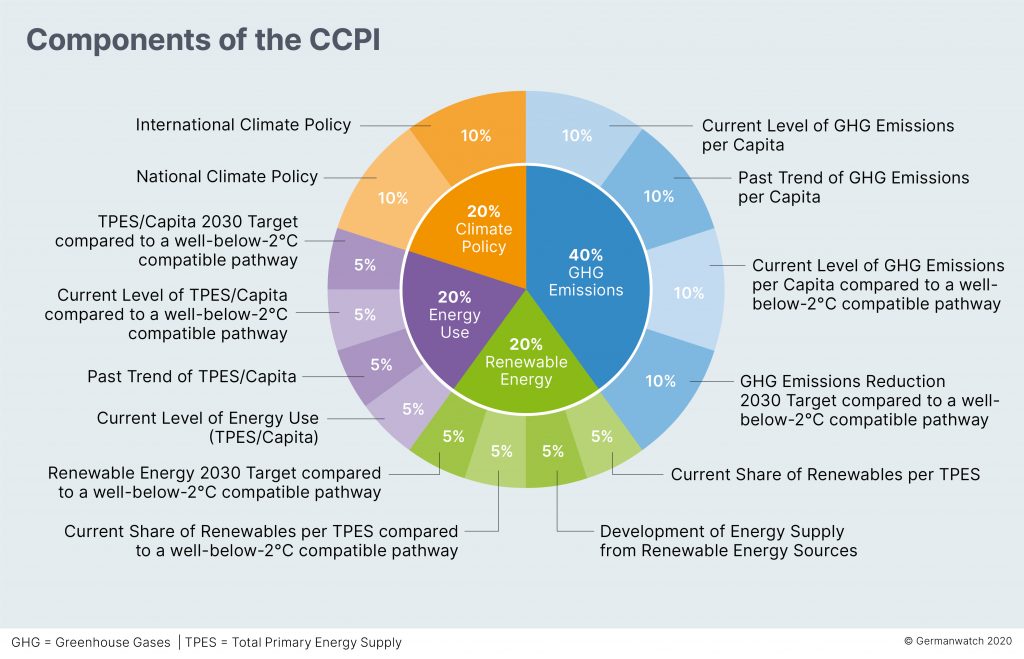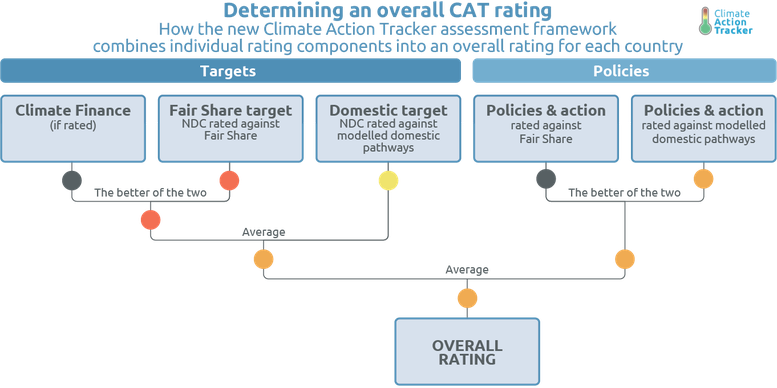
How to Measure Countries’ Climate Performance
There are several metrics and possibilities to measure the performance of climate policies and actions, which differ in methodology and indicator choice.
Our Climate Change Performance Index (CCPI) measures the climate performance of 59 countries (and the EU) that are collectively responsible for over 90% of global emissions. All major economies and many emerging economies are included.
The CCPI is based on criteria including the country’s emissions levels, energy use, and use of renewable energy, as well as its climate policies (find more about our methodology here). Other indexes place their focus in different areas and this post will examine those, as well, giving credit where due, because all the indexes serve an important role.
This post examines the importance of scientific climate performance indexes, and how you can understand them.
Why should we measure climate performance?
The climate crisis is an existential threat, and we must, more than ever, watch for causes and watch who’s doing their part to help lessen it. To do this, we need quantitative and qualitative measurements and comparisons.
Even if climate change is now unavoidable, it can be lessened. One absolute must is that countries change their economies to limit global warming to well below 2°C. In 2015, nearly all countries committed to this goal and adopted the Paris Agreement. And without reliable data, it’s hard to know whether countries are following through on their promises, and how much they must improve their actions.
More than ever, transparency and accountability for civil society and the public are needed to ensure leaders and governments are doing what they said they’d do, or even doing the opposite. Measuring and publishing the climate performance of countries informs people and demands national accountability.
Indexes such as the CCPI can help in the following, and more, ways:
- Increase political pressure
- Improve climate information outreach to citizens
- Inform the financial market about the leaders and laggards for sovereign debt analysis
- Advance international climate policy research
- Provide civil society groups and lawmakers with sound arguments for more climate protection
Composite indexes are one option for facilitating and illustrating complex issues. They are useful tools for decision-makers, civil society, and the broader public to identify trends and can benchmark a national climate performance.
How the CCPI measures climate action: From outputs to outcomes
Since 2005, the CCPI has provided an annual ranking of countries that are collectively responsible for 90%+ of all global greenhouse gas emissions. In CCPI 2023, we looked at the climate mitigation efforts of 59 countries and the EU.
For us, climate protection measurement goes beyond just emissions. The CCPI includes data on greenhouse gas emissions, climate policy, renewable energy, and energy use.
We believe good climate policy is the first step toward improvements in energy use and renewable energy, which ultimately leads to lower emissions. Expansion of renewables and energy saving are the backbones of decarbonisation. The CCPI methodology also reflects policy improvements and Paris Agreement compatibility.

Overall, the CCPI comprehensively shows which countries rate as having high, medium, low, or very low performance in their climate actions, but in categories and overall.
We use 14 indicators, starting with data from internationally recognized institutions, and collect our own qualitative information in our unique climate policy survey. For CCPI 2023, 450 national climate experts provide us with information about the most recent policy developments in their countries.

Best-known approaches to measuring climate performance
The CCPI isn’t the only index that measures performance regarding climate action. Others may focus on different themes, which are no less valid and relevant. The CCPI focuses on the transition steps countries must go through to achieve lower emissions. There are merits in each approach. Some of the most known approaches are as follows.
Climate Action Tracker
The Climate Action Tracker (CAT) is one of the best-established climate tracker and is conducted by Climate Analytics and the NewClimate Institute. The CAT evaluates the climate mitigation targets, policies, and actions of 39 countries and the EU. It includes policies, actions, domestic and internationally supported targets, ratings of fair share targets, and assessments of climate finance for some countries.
Using greenhouse gas emissions projections, the CAT can measure countries’ announced climate targets vs. the Paris Agreement pledges. Countries can receive one of five rating categories, ranging from ‘critically insufficient’ for little to no climate action towards achieving the Paris Agreement target, to ‘1.5°C Paris Agreement compatible’ for full compliance with it. ‘Highly insufficient’, ‘insufficient’ and ‘almost sufficient’ form the range in between.
None of the assessed countries are Paris-compatible, while nine – including Costa Rica, Norway, and Ethiopia – receive an ‘almost sufficient‘ rating. Out of the remaining countries, 12 rate as ‘insufficient’, 10 are ‘highly insufficient’ and seven are ‘critically insufficient’.

The CAT is the leading tool for assessing climate policies’ and targets’ compatibility with the Paris Agreement. Unlike the CCPI, the CAT is an absolute ranking focusing on 2030 policies and targets rather than past trends and current levels.
For more in-depth information on the CAT, see its methodology and recent results.
Net Zero Tracker
The Net Zero Tracker is a collaborative project between the Energy & Climate Intelligence Unit, Data-Driven Envirolab, NewClimate Institute, and Net Zero. It evaluates the net zero pledges of the top 25 emitting nations, states, regions, and all cities with more than 500,000 inhabitants, as well as the 2,000 largest publicly traded companies.
The Net Zero tracker assesses:
- Targets
- Plans, reporting obligations, clarity on offsets, coverage of all emissions and near-term goals
- Progress on pledges
The Net Zero Tracker authors hope to show the credibility of net zero targets as they are the main form of decarbonisation targets. Credibility differs hugely across different countries, regions, cities, and companies.
Unlike the CCPI, the Net Zero Tracker focuses on long-term net-zero commitments and analyses a broader spectrum of actors like cities or regions. More information can be found here
Environmental Performance Index
The Environmental Performance Index (EPI) includes, apart from climate change mitigation, indicators on environmental health and ecosystem vitality. A total of 40 indicators in the EPI overview the state of sustainability in 180 countries.
Since 2002, Yale University and the University of Colombia have published this index biannually. In assessing climate change mitigation, the EPI uses a combination of adjusted growth rates, projected emissions levels in 2050, annual growth rates from CO2 emissions from land cover change, greenhouse gas intensity growth rate, and greenhouse gases per capita.
The EPI focuses on changes in emissions over the years and into the future. Unlike the Net Zero Tracker and CAT, the EPI creates a comprehensive ranking, similar to the CCPI.
Find out more about the EPI here.

Other indexes: Climate action is not just mitigation
Climate change is complex and multifaceted. The more climate change progresses and the impacts of global warming become visible, the more aspects of climate change adaptation come into focus.
The Climate Change Vulnerability Index, ND-Gain Country Index, and Climate Risk Index focus on questions surrounding risk, adaptation, and impacts. Each niche warrants attention.
This variety of different indices, which examine and clarify different angles of the climate change problem, is important. No single index can capture the complexity of climate change. Examine each of them to get a comprehensive image of who is and is not performing well.
Authors